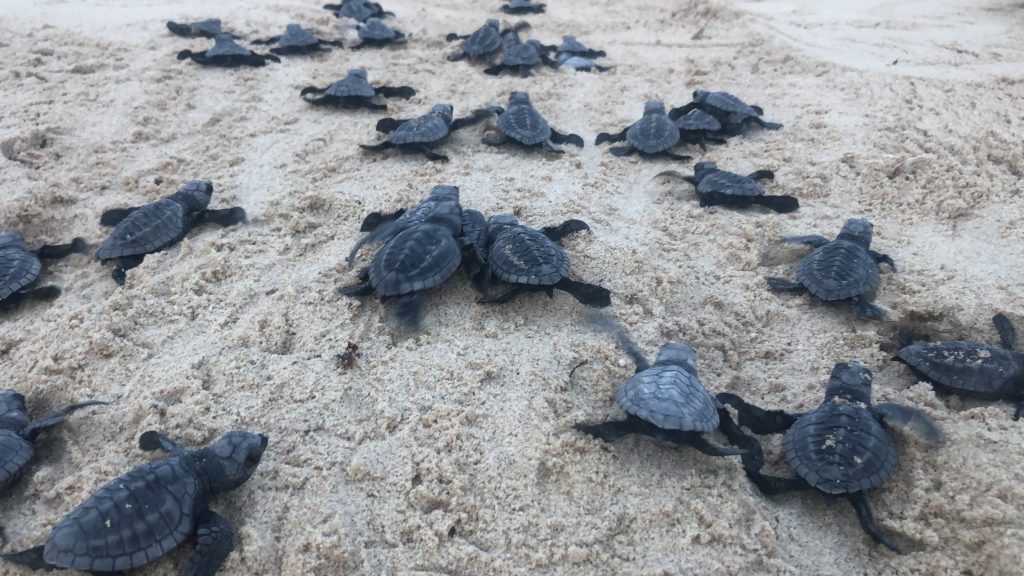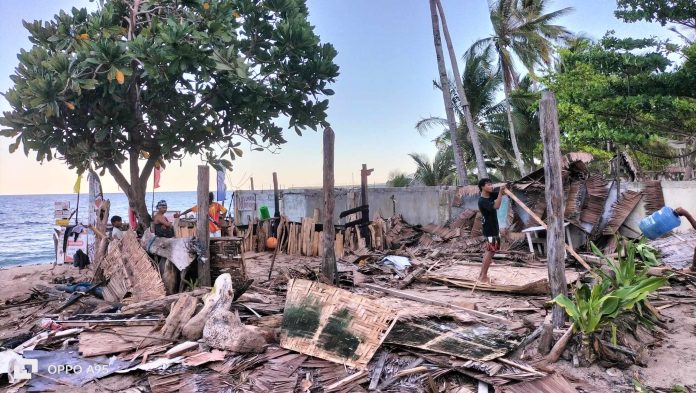At around 10 AM on May 21, 2024, personnel from the Public Safety Office and the Dahican Shoreline Management Task Force spearheaded the demolition of a 20-year-old watchtower built on Dahican’s shoreline.
The monitoring tower, along with a pawikan (sea turtle) hatchery, was built by Amihan sa Dahican – Balod sa Paglaom Inc., an environmental conservation organization.
Although iconic, the tower was not intended for tourism. It served as a humble place of rest for locals who volunteered to patrol the shores of Dahican, which is a breeding ground for pawikans.”
The area in question
In a Facebook post, the Mati City Local Government Unit (LGU) announced plans to use the area for a ‘baywatch tower’ or ‘substation’ for the ‘Task Force Mati Shoreline Management.’
The task force includes the Philippine Coast Guard, Mati Tourist Police, Philippine Maritime Police, Bantay Dagat, BFAR, and other agencies.
In the same post, the LGU noted that their goal with this new plan is to ensure the safety of everyone swimming in the seas of Dahican—locals and tourists alike—and to prevent pollution problems.
It is worth noting that the area where the 20-year-old watchtower was built is public domain.
According to the 1987 Constitution of the Republic of the Philippines – Article XII Section 2, “All lands of the public domain, waters, minerals, coal, petroleum, and other mineral oils, all forces of potential energy, fisheries, forests or timber, wildlife, flora and fauna, and other natural resources are owned by the State. With the exception of agricultural lands, all other natural resources shall not be alienated.”
While this same constitutional provision underscores that ‘the exploration, development, and utilization of natural resources shall be under the full control and supervision of the State,’ it also allowed Amihan sa Dahican – Balod sa Paglaom Inc. to build a watchtower and a pawikan hatchery.
The project was managed under the Integrated Coastal Resources Management Project, in collaboration with the Department of Environment and Natural Resources (DENR).
The Mati City government announced on Facebook that they have new plans for the Dahican shoreline, a breeding area for pawikans.
The city’s priorities now include establishing a fishing/mooring area, a navigation lane for local fisherfolk, and three distinct zones: a ‘no swimming zone,’ a ‘swimming zone,’ and an ‘angling area.’
The post did not specify what these plans entail for the pawikans in Dahican.

Mati City’s marine biodiversity
Mati City boasts a rich marine biodiversity, underscored by Pujada Bay’s abundance of various fish and coral species, making it a renowned dive site in Davao Oriental.
While Dahican is popular for sports activities like surfing and skimboarding, it is equally important as a breeding ground for the green sea turtle, hawksbill sea turtle, and olive ridley sea turtle, which NOAA Fisheries lists as endangered, critically endangered, and vulnerable, respectively.
Mati is also home to other islands, such as Oak Island and Waniban Island, each offering its own unique appeal.
In 2020, television broadcaster GMA’s ‘Born to Be Wild’ documented the journey of the pawikans in Dahican, from the mothers laying eggs to the hatchlings making their way back to the sea.
Then, in 2021, the city was lauded for achieving a record with the most sea turtle hatchlings released into the Philippine seas, totaling 105,000 over the past three years along the shores of Dahican.
Media coverage like this is a testament to the city’s environmental grandeur.
The plight of a grassroots environmental organization
Today, grassroots organizations like Amihan sa Dahican – Balod sa Paglaom Inc. face challenges in continuing their advocacy as more businesses enter the city.
The team, which was recognized during the 6th Gawad Bayani ng Kalikasan in 2021, seeks a balance between commercialization and environmental care.
They do not adopt an ‘us vs. them’ mentality; instead, they aim to collaborate with the city to develop a plan that serves both the interests of the city and the locals—a goal that remains unachieved, despite multiple letters sent to the City Administrator’s office.
The mission of Amihan sa Dahican has always been to continuously strengthen their conservation efforts and educate the public about pawikans and marine biodiversity, all while maintaining sustainability for environmental protection.
For decades, even with limited resources, this team never gets tired of patrolling the shores of Dahican.
They consistently monitor the traces of marine turtles, transfer eggs to the hatchery for protection, and release pawikan hatchlings at night when their chances of survival are highest.
As of this writing, despite the demolition of their tower and the pending demolition of the pawikan hatchery, the Amihan team continues to monitor the 3,000 pawikan eggs still in their care, releasing hatchlings when the time comes.
If that isn’t a testament to passion and dedication, then what is?
The fate of Dahican’s pawikans
As the Mati City LGU continues to pursue further development, the fate of the pawikans in Dahican hangs in the balance, with their hatcheries threatened by demolition.
This shoreline is a magnet for tourists, boasting a white sand beach, pristine waters, and massive swells for surfing.
However, it is also home to three species of pawikans. While the local government has built hatcheries in another area, Menzi, there is no concrete plan regarding the pawikans hatched in Dahican who will return to this very same shoreline to lay their eggs 25 years later.
Perhaps a better way to put it is this: What kind of shoreline will these pawikans encounter if those in power do not protect it as diligently as the local communities currently do?
Tammy Danan is a freelance writer based in the Philippines. She reports on social and environmental issues, with a special focus on the climate crisis, gender inequality, and the struggles of indigenous peoples. Her work has appeared in Rest of World, VICE, Ozy, ZEKE Magazine, Al Jazeera, and other publications.









